Active Door
The door in a double-door set that is opened first and to which a functionable lockset is applied.
Backset
The horizontal distance measured from the edge of the door to the center-point of the bore hole.
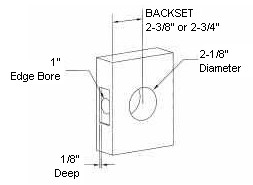 The door-prep image seen to the left applies to any standard tubular lock or latch set including interior door knobs, door levers, deadbolts, entry door handle set, and door handle plates.
The door-prep image seen to the left applies to any standard tubular lock or latch set including interior door knobs, door levers, deadbolts, entry door handle set, and door handle plates.
You can see the bore hole that is 2-1/8" in diameter. The distance from the edge of the door to the center-point of this bore hole is the backset.
Most interior doors have a 2-3/8" backset. Most exterior doors have a 2-3/4" backset.
Bore
The large hole that is physically drilled through your door to allow for installation of hardware (such as a latchset like a door knob, lever, deadbolt, entry set, etc.). Bore holes are usually 2-1/8" in diameter.
Center-to-Center Hole Spacing
The vertical distance measured between the center-points of two bore holes.
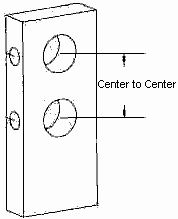 This measurement is most often need for tubular entry door handle sets, where a bore for the deadbolt is located above the bore for the latch.
This measurement is most often need for tubular entry door handle sets, where a bore for the deadbolt is located above the bore for the latch.
Custom Keying
An option chosen for how we will key your door lock (such as a deadbolt, entry set, etc). Custom keying indicates you will supply either a copy of a key or a key-code that you would like your new lock to accept.
Cylinder
The cylindrical shaped mechanism housed within door locks that contains the tumbler and keyway, into which a key is inserted to operate the lock.

Deadbolt
A heavy duty door lock that has no spring action, but is operated by a key or a thumbturn. Locking action will slide a metal bolt from the door deep into the door-jamb to securely lock the door. A security feature often used on exterior doors. Deadbolts are often combined with a locking knob or lever and are positioned above them on a door.
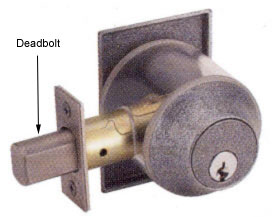
Door Handle Plate
A large decorative plate that covers any bored hole in a door with an attached knob or lever.

Door Swing
The direction the door opens while standing on the outside.
If you stand on the outside of the door and you push it away from yourself to open, it is IN-SWING.
If you stand on the outside of the door and you pull it towards you to open, it is OUT-SWING.
Double Cylinder
 Double cylinder door locks require a key to lock/unlock your door from both the outside and inside. The double cylinder function is an option for door locks like deadbolts and entry sets. Double cylinder locks are usually not recommended because they make it more difficult to exit your home in case of an emergency.
Double cylinder door locks require a key to lock/unlock your door from both the outside and inside. The double cylinder function is an option for door locks like deadbolts and entry sets. Double cylinder locks are usually not recommended because they make it more difficult to exit your home in case of an emergency.
Dummy (pair)
 A dummy pair indicates a pair of handles that have no latching or locking functions. They are surface mounted to a door simply to give the door a handle to pull it open. Dummy pairs are usually used for the inactive door in a double-door set and other doors that need a handle on both sides, but no latching or locking function.
A dummy pair indicates a pair of handles that have no latching or locking functions. They are surface mounted to a door simply to give the door a handle to pull it open. Dummy pairs are usually used for the inactive door in a double-door set and other doors that need a handle on both sides, but no latching or locking function.
Dummy (single)
 A single dummy handle indicates one handle that has no latching or locking function. It is surface mounted to a door simply to give the door a handle to pull it open. Single dummy handles are usually used on closet doors, bifold doors, or other doors where one handle is needed, but no latching or locking function is.
A single dummy handle indicates one handle that has no latching or locking function. It is surface mounted to a door simply to give the door a handle to pull it open. Single dummy handles are usually used on closet doors, bifold doors, or other doors where one handle is needed, but no latching or locking function is.
Edge Bore
The hole that is drilled into the edge of the door, connecting from the edge of the door to the larger main bore hole.

Faceplate
Faceplate refers to the small, rectangular-shaped piece of metal that surrounds the door latch on the edge of the door.

Finish
The color of your door hardware. Most hardware has a variety of finish colors to choose from. Finish are applied as a protective coating.
Function
The function of your door hardware refers what mechanisms are used and how they operate in your hardware. Interior hardware such as door knobs and door levers are available in passage, privacy, or dummy functions. Exterior hardware such as deadbolts and entry sets come in single-cylinder and double-cylinder functions. Door knobs and levers can also have a key-in function.
Handing
Sometimes it is required that you know the "handing" of your door handle to indicate which direction the handle turns or operates. Handing must be determined for each door. You often will need to know handing if you are ordering a door lever, an entry door handle, or a mortise lock set.
Handles are either "Left Hand" or "Right Hand."
To determine handing:
1. Stand on the outside of the door. For instance, if you are getting the handing for the front entry door of your house, stand outside of the whole house; if you are getting the handing for a bathroom door, stand outside the bathroom; for a bedroom, stand outside the bedroom; and so on.
2. Facing the door, see what side the hinges are located.
"Left Hand" = The hinges are on the left side of the door.
"Right Hand" = The hinges are on the right side of the door.
That's it!! Ignore which way the door swings.
Use the diagram below as an additional aide to determine handing.

Inactive Door (in a double door)
The door in a double-door set that does not contain a latch-set, but instead is bolted at the top and bottom to hold it stationary when shut. This door receives the latch or bolt of the active door.
Interconnect Device
A device that can be assembled into an entry set that allows you to disengage both the deadbolt and the lower latch at the same time just by operating the handle. Your door will open with this single action, as opposed to the usual two actions of first unlocking the top deadbolt before operating the handle.
Jamb
The door frame to which the door's hinges are attached that surrounds the door when it's closed.
Keyed Alike
A keying option indicating that you want ALL the cylinders in your order to operate by the same key.
Keyed Differently
A keying option indicating that you want the cylinder for one particular door lock to operate by its own unique key.
Keying
An option for door locks such as deadbolts or entry door handle sets used to specify how the cylinder in the lock should be keyed. Keying options are keyed alike or keyed differently.
Key-In Knobs or Lever
 Knobs or levers that contain a cylinder on the exterior side that can be locked/unlocked by a key. The interior side has a thumbturn to operate the locking function. Key-in door knobs and levers are often combined with a deadbolt installed above it for best security.
Knobs or levers that contain a cylinder on the exterior side that can be locked/unlocked by a key. The interior side has a thumbturn to operate the locking function. Key-in door knobs and levers are often combined with a deadbolt installed above it for best security.
Latch
 The beveled "tongue" spring mechanism that extends from the edge of the door into the door jamb to hold the door shut when closed.
The beveled "tongue" spring mechanism that extends from the edge of the door into the door jamb to hold the door shut when closed.
Mortise Lock
The most secure form of an entry set that combines the two functions of locking and latching into one large mortise lock-box. Mortise locks require special tools and door-prep methods that often must be performed by professionals. This special machining of the door allows the whole thick mortise lock-box to be installed into the door for maximum protection.
Here is a sample drawing of a mortise lock-box.
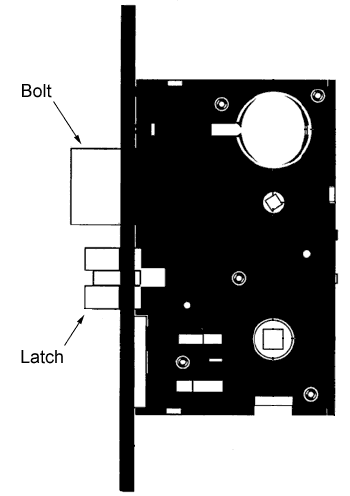
Passage (Function)
 A function for interior door handles for general access doors that require a latch feature, but no locking feature. Commonly used for hallway doors, closet doors, laundry room doors, etc.
A function for interior door handles for general access doors that require a latch feature, but no locking feature. Commonly used for hallway doors, closet doors, laundry room doors, etc.
Pocket Door
A type of door installed on a sliding track that slides into and out of a hollowed space in a wall. Any standard door can be used as a pocket door. Pocket doors are used to free up space in a room by eliminating the necessity to maintain clearance for the action of a swinging door.

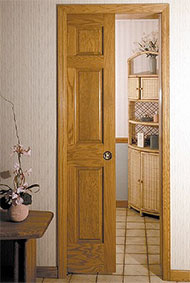
Privacy (Function)
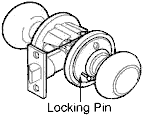 A function for interior door handles for use on doors of private rooms that require a latch and a simple locking feature. Commonly used for bedroom doors, bathroom doors, etc.
A function for interior door handles for use on doors of private rooms that require a latch and a simple locking feature. Commonly used for bedroom doors, bathroom doors, etc.
Rosette
The decorative backplate attached to a door knob or lever that covers the bore hole in the door.

Single Cylinder
 Single-cylinder door locks require a key to lock/unlock your door from the outside; and have a thumbturn mechanism on the inside to lock/unlock your door. The single-cylinder function is an option for locks such as deadbolts and entry sets. The thumbturn on the inside allows for an easy exit in case of an emergency.
Single-cylinder door locks require a key to lock/unlock your door from the outside; and have a thumbturn mechanism on the inside to lock/unlock your door. The single-cylinder function is an option for locks such as deadbolts and entry sets. The thumbturn on the inside allows for an easy exit in case of an emergency.
Split Finish
When the exterior portion of door hardware has a different finish color than the interior portion. To notate a split-finish, always refer to the exterior finish color first.
Proper notation is as follows: Exterior Finish X Interior Finish
Example: Satin Nickel X Polished Brass - indicates the exterior finish will be Satin Nickel, and the interior finish will be Polished Brass.
Strikeplate
The metal plate installed on the door jamb that receives the latch or bolt from the door. The latch/bolt extends from the door into the strikeplate.

Tubular (Lock or Latch)
Any door lock-set or latch-set that requires a bore hole and an edge-bore for installation.
A standard interior door handle requires one bore hole (usually 2-1/8" in diameter) and one edge-bore (usually 1" in diameter).
A tubular entry door handle set requires two such bores that are usually spaced either 3-5/8" or 5-1/2" apart from center-to-center.

